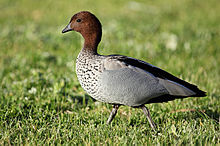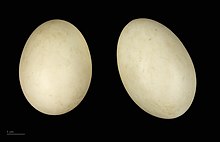Mane goose
| Mane goose | ||||||||||
|---|---|---|---|---|---|---|---|---|---|---|

Maned Goose (behind male and in front female) |
||||||||||
| Systematics | ||||||||||
|
||||||||||
| Scientific name of the genus | ||||||||||
| Chenonetta | ||||||||||
| Brandt , 1836 | ||||||||||
| Scientific name of the species | ||||||||||
| Chenonetta jubata | ||||||||||
| ( Latham , 1802) |
The maned goose ( Chenonetta jubata ) is the only surviving species in the genus of the mane geese ( Chenonetta ) and belongs to the family of duck birds (Anatidae). It got its name because of the erectable feathers on the back of the male's head. It belongs to the fauna of Australia and occurs there in two disjoint distribution areas. No subspecies are distinguished. The species is therefore considered to be monotypical . It is closely related to the extinct Finsch's duck ( Chenonetta finschi ).
In Australia, the mane goose counts for game birds and is heavily hunted.
features
general characteristics
The maned goose is a medium-sized duck. It reaches a body length of 44 to 51 centimeters and weighs around 800 grams. In her body shape and the way she eats, she is reminiscent of a little goose. The body is generally plump, the legs are relatively long. Males and females are the same size. The beak is short and blunt, but the head is relatively large. Because of its body shape and the conspicuously spotted chest, it is not to be confused with any other species in its natural range. It can usually be seen in troops. The loud meowing calls of the males can be heard from a distance. In flight, the white under wing-coverts are particularly noticeable, which differ greatly from the dark under tail plumage and the dark belly.
feather dress
Males have a brown head and speckled, white-black to gray-black breast plumage. At the back of the head they have a mane-like head that they can also put up. The body plumage is predominantly drawn in a fine gray, the dorsal plumage, the trunk, tail and the belly, however, are black-brown. The beak is dark gray. The legs and feet are gray-brown. The eyes are dark brown. In summer the male often changes to a resting dress that resembles the plumage of the female. It is possible that the resting dress is only put on by males who have successfully had offspring.
The female has a light brown head and gray-brown plumage . There are white stripes under and above the eyes. The breast is spotted similar to that of the male, even if the intensity of the color is a little more subdued. Brown stripes can be found on the underside of the body. The young birds are similar in plumage color to the female. But they are overall a little paler and their breasts are streaked and not spotted.
Adult mane geese change their plumage twice a year. The swinging moult occurs after the breeding season. It can be omitted if there is extreme drought during this period.
Behavior patterns and locomotion
Basically, the mane geese can be seen in pairs or even more often in small flocks in sparse tree-lined areas near water, on sandbanks or dams and in swamps. They spend 29 percent of their time resting, 33 percent graze near water. They spend less than seven percent of the day on the water. However, if they are concerned, they flee onto the water. On moonlit nights they also graze at night. On land the mode of locomotion is similar to geese, on the water they seem awkward to humans. They very rarely dive. In flight, their wing flaps are very slow compared to other duck species, but their flight is overall fast and they are agile fliers.
Mane geese are generally sociable birds, only during the breeding season pair observations predominate. The flocks that form after the breeding period are seldom stable in composition, as pairs continuously leave the flock and new pairs join the flock. Troops can contain more than 2,000 individuals, but troops with fewer than 100 individuals are more typical.
Distribution and existence
The distribution area includes Australia including Tasmania . The maned goose is generally considered to be a very widespread species. Suitable habitats, such as those that arise after heavy rainfall in otherwise drier regions of Australia, are quickly populated by it; In regions that have permanently suitable habitats, on the other hand, it is more localized. Rediscoveries of ringed birds show that many mane geese roam a relatively small area. However, individual finds also prove hikes of more than 3,000 kilometers.
The maned goose is absent in the far north of Australia. The very arid zone, which stretches from the north-west of Australia through the entire continent, represents the distribution gap of this species. As a stray visitor it is occasionally found in New Zealand . Observations in New Zealand have so far been limited to the South Island.
Their populations appear to be increasing in Tasmania. However, there is a lack of reliable inventory figures. Counts are mostly made from airplanes and are therefore not always complete. Overall, the population of this species is estimated at more than 500,000 individuals. In years with sufficient rainfall, their population can exceed the million mark. The IUCN classifies the mane goose as not endangered ( least concern ).
habitat
The mane goose is mainly found in the eastern and southwestern regions in pairs or small groups on meadows or wooded upper reaches of the rivers. Although she is a good swimmer, she is less likely than other ducks to be in the water.
Food and diet
The mane goose feeds on grasses as well as seeds and herbs . It also accepts insects. She finds her food mainly through grazing, she uses both day and night times for this. Mane geese, observed for long periods in New South Wales, spent 96 percent of their foraging time grazing. Insects catch them by moving rapidly forward both on land and on water. They seldom dig and chattering through mud is probably more used for picking up small stones than for actually foraging.
Downy chicks initially eat almost exclusively insects; however, one has also observed downy chicks, which from their third day of life spent most of their time grazing.
Reproductive biology
Mane geese enter into long-term relationships that may last until the death of one of the partner birds. In mane geese observed over a period of three years, the shortest pair bond was 16 months. They enter into couple relationships during their first year of life and can start the breeding business in their first year. Couples stay together all year round and choose the nesting location together. While the female is breeding, the male stays nearby and usually accompanies the female when she leaves the nest to eat.
Mane geese are cave breeders and usually use tree hollows. Successful couples usually use last year's breeding cave again. The breeding season varies depending on the geographical distribution. In New South Wales, Australia, the breeding season usually falls between July and December. In principle, mane geese can brood all year round if the conditions are suitable. In particularly suitable habitats, they also raise two broods per year. Mane geese are not particularly territorial during the breeding season. Males, whose females were just breeding, tolerated conspecifics in the immediate vicinity of the nest and even joined them while grazing.
The clutch consists of eight to twelve cream-colored eggs that are hatched over a period of 28 days. If the clutch is destroyed, they are able to produce a second clutch. The young leave the brood cave shortly after hatching, while the female parent bird lures them with calls. Both parent birds lead the downy chicks to a body of water. Occasionally they cover a distance of up to a kilometer.
The predators of clutches and young birds include the New Holland crow , the white-cheeked heron and the Jägerliest . Peregrine falcon , hawk falcon , wedge-tailed eagle , foxes and feral domestic cats can also beat adult mane geese.
supporting documents
literature
- PJ Higgins (Ed.): Handbook of Australian, New Zealand & Antarctic Birds , Volume 1, Ratites to Ducks, Oxford University Press, Oxford 1990, ISBN 0195530683
- Janet Kear (Ed.): Ducks, Geese and Swans. Oxford University Press, 2005, ISBN 0-19-854645-9 .
- Hartmut Kolbe; Die Entenvögel der Welt , Ulmer Verlag 1999, ISBN 3-8001-7442-1
- Steve Madge , Hilary Burn: Wildfowl: An Identification to the Ducks, Geese and Swans of the World. 1987, ISBN 0-7470-2201-1 .
Individual evidence
- ^ IOC World Bird List Screamers, ducks, geese, swans
- ↑ a b c P. J. Higgins (Ed.): Handbook of Australian, New Zealand & Antarctic Birds , Volume 1, Ratites to Ducks, p. 1241
- ↑ a b Janet Kear (Ed.): Ducks, Geese and Swans , p. 469
- ↑ a b P. J. Higgins (Ed.): Handbook of Australian, New Zealand & Antarctic Birds , Volume 1, Ratites to Ducks, p. 1240
- ↑ a b c d e f P. J. Higgins (Ed.): Handbook of Australian, New Zealand & Antarctic Birds , Volume 1, Ratites to Ducks, p. 1242
- ^ PJ Higgins (Ed.): Handbook of Australian, New Zealand & Antarctic Birds , Volume 1, Ratites to Ducks, p. 1243
- ^ PJ Higgins (Ed.): Handbook of Australian, New Zealand & Antarctic Birds , Volume 1, Ratites to Ducks, p. 1344
- ↑ a b c P. J. Higgins (Ed.): Handbook of Australian, New Zealand & Antarctic Birds , Volume 1, Ratites to Ducks, p. 1244
- ^ PJ Higgins (Ed.): Handbook of Australian, New Zealand & Antarctic Birds , Volume 1, Ratites to Ducks, p. 1245
Web links
- Chenonetta jubata in the endangered Red List species the IUCN 2008. Posted by: BirdLife International, 2008. Accessed January 31 of 2009.
- Videos, photos and sound recordings of Chenonetta jubata in the Internet Bird Collection




